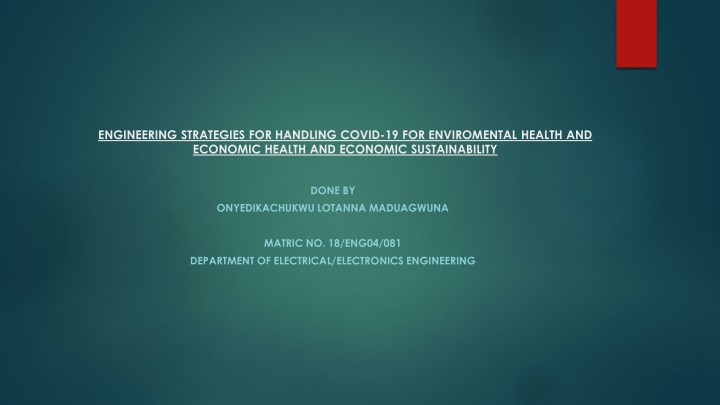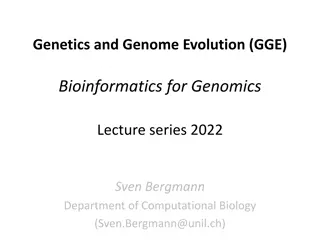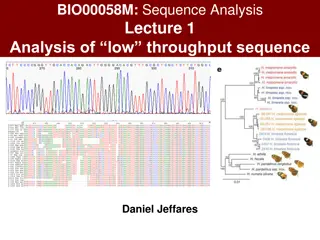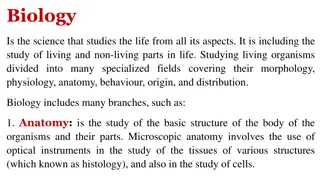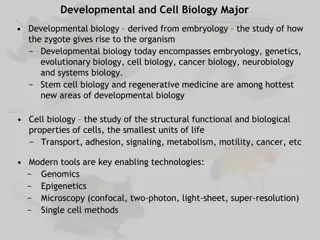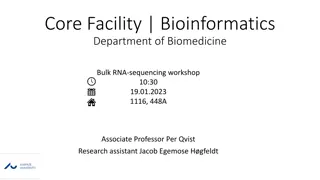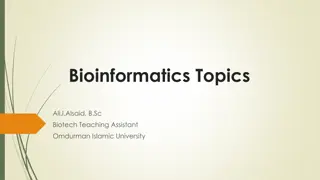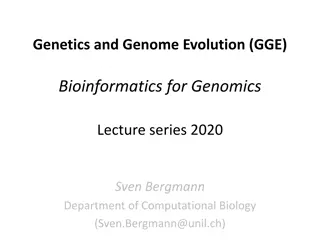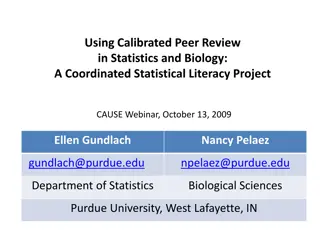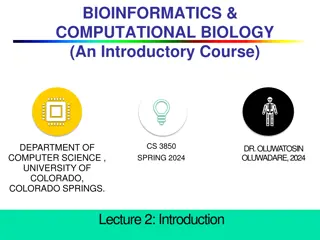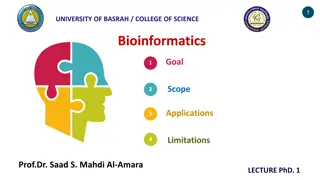Bioinformatics: Where Biology and Technology Intersect
In bioinformatics, biology merges with computer science and information technology, allowing for the analysis of molecular data to answer biological questions. From DNA sequencing technologies to the development of databases and online querying systems, bioinformatics plays a crucial role in advancing scientific research. Explore the fascinating world where genes, proteins, and computation converge.
Download Presentation

Please find below an Image/Link to download the presentation.
The content on the website is provided AS IS for your information and personal use only. It may not be sold, licensed, or shared on other websites without obtaining consent from the author.If you encounter any issues during the download, it is possible that the publisher has removed the file from their server.
You are allowed to download the files provided on this website for personal or commercial use, subject to the condition that they are used lawfully. All files are the property of their respective owners.
The content on the website is provided AS IS for your information and personal use only. It may not be sold, licensed, or shared on other websites without obtaining consent from the author.
E N D
Presentation Transcript
ENGINEERING STRATEGIES FOR HANDLING COVID-19 FOR ENVIROMENTAL HEALTH AND ECONOMIC HEALTH AND ECONOMIC SUSTAINABILITY DONE BY ONYEDIKACHUKWU LOTANNA MADUAGWUNA MATRIC NO. 18/ENG04/081 DEPARTMENT OF ELECTRICAL/ELECTRONICS ENGINEERING
ABSTRACT Bioinformatics is an interdisciplinary field that develops methods and software tools for understanding biological data. As an interdisciplinary field of science, bioinformatics combines computer science, statistics, mathematics, and engineering to analyze and interpret biological data. Bioinformatics is considered both an umbrella term for the body of biological studies that use computer programming as part of their methodology, as well as a reference to specific analysis "pipelines" that are repeatedly used, particularly in the field of genomics. Common uses of bioinformatics include the identification of candidate genes and nucleotides (SNPs). Often, such identification is made with the aim of better understanding the genetic basis of disease, unique adaptations, desirable properties (esp. in agricultural species), or differences between populations. In a less formal way, bioinformatics also tries to understand the organisational principles within nucleic acid and protein sequences. This principle is a factor used to determine viruses and also used to fight them.
Table of Contents CHAPTER ONE History of Engineering in medicine What is biomedical engineering CHAPTER TWO Elect/elect engineering in medicine Function of ventilators Principles of ventilators CHAPTER THREE CHAPTER THREE Importance of communication, connectivity (5G) and Robotics in Handling a pandemic Way 5G and robotics can be applied in the medical field CONCLUSION CONCLUSION
CHAPTER ONE HISTORY OF ENGINEERING IN MEDICINE The history of the IEEE EMBS runs hand in hand with the history of Biomedical Engineering both as a scientific discipline and as a profession. The conferences and publications led by IEEE EMBS, amongst other activities were a mirror of the evolution of Biomedical Engineering over the years and they equally contributed to shape Biomedical Engineering as we view it today. The IEEE EMBS provides a testimony of how a broad and diverse scientific community that comes from many diverse areas such as medicine, engineering, physics and chemistry and shares common purposes and interests can successfully work under the same designation of biomedical engineers. This account is a review of the history of Biomedical Engineering and the development of the IEEE EMBS since the inception of its predecessors, the AIEE Committee on Electrical Techniques in Medicine and Biology and the IRE Professional Group in Medical Electronics
WHAT IS BIOMEDICAL ENGINEERING Biomedical engineering (BME) or medical engineering is the application of engineering principles and design concepts to medicine and biology for healthcare purposes (e.g. diagnostic or therapeutic). This field seeks to close the gap between engineering and medicine, combining the design and problem solving skills of engineering with medical biological sciences to advance health care treatment, including diagnosis, monitoring, and therapy. Also included under the scope of a biomedical engineer is the management of current medical equipment within hospitals while adhering to relevant industry standards. This involves making equipment recommendations, procurement, routine testing and preventive maintenance, a role also known as a Biomedical Equipment Technician (BMET) or as clinical engineering
CHAPTER 2 ELECRTRICAL/ELECTRONIC ENGINNERING IN MEDICINE There are different strategies that can be put in place for the enhancement of environmental health and to help in curbing pandemics, in the case of the coronavirus(COVID-19) due to the complexity of the virus it tends to affect the respiratory ducts living patients docile due to the lack of air caused by fibrosis however electronics engineering can be implemented in the case of ventilation process, machines can be built to help in assisting respiration an example of thus electrical machines is a ventilator
WHAT IS A VENTILATOR A ventilator is a machine that provides mechanical ventilation by moving breathable air into and out of the lungs, to deliver breaths to a patient who is physically unable to breathe, or breathing insufficiently. Modern ventilators are computerized microprocessor controlled machines, but patients can also be ventilated with a simple, hand-operated bag valve mask. Ventilators are chiefly used in intensive care medicine, home care, and emergency medicine (as standalone units) and in anesthesiology (as a component of an anesthesia machine). Ventilators are sometimes called respirators, a term commonly used for them in the 1950s (particularly the "Bird respirator ). However, in contemporary hospital and medical terminology, a respirator is a protective face mask
FUNCTION OF A VENTILATOR In its simplest form, a modern positive pressure ventilator consists of a compressible air reservoir or turbine, air and oxygen supplies, a set of valves and tubes, and a disposable or reusable "patient circuit". The air reservoir is pneumatically compressed several times a minute to deliver room-air, or in most cases, an air/oxygen mixture to the patient. If a turbine is used, the turbine pushes air through the ventilator, with a flow valve adjusting pressure to meet patient- specific parameters. When over pressure is released, the patient will exhale passively due to the lungs' elasticity, the exhaled air being released usually through a one-way valve within the patient circuit called the patient manifold.
PRINCIPLE OF VENTILATORS Breathe in, breathe out The principal function of a ventilator is to pump or blow oxygen-rich air into the lungs; this is referred to as oxygenation . Ventilators also assist in the removal of carbon dioxide from the lungs, and this is referred to as ventilation . One basic type of ventilator is the Bag Valve Mask (BVM). The BVM, also known as the Ambu Bag, is operated manually by a person squeezing a self-inflating bladder. This is an essential tool for ambulance crews, first responders and critical care units. It is light, compact and easy to use. However, in situations where a steady and controlled air exchange (oxygen in, carbon dioxide out) is needed, mechanical ventilators are required. These look like a quintessential medical product.
CHAPTER 3 IMPORTANCE OF COMMUNICATION, CONNECTIVITY(5G) AND ROBOTICS IN HANDLING A PANDEMIC The world is considered a global village, due to the ease of access to information and connectivity but it also isn t the only reason the world is a global village. Other examples of why the world can be considered a global village is trade, ease of transportation thus factors can be detrimental in a case of a pandemic especially if the virus is easily transmitted, various precautions can be taking to reduce the impact of such pandemics like social distancing and basic hygiene but such measures aren t enough. For the safety of the health workers and citizens connectivity and robotics comes into play.
WAYS 5G AND ROBOTICS CAN BE APPLIED IN THE MEDICAL FIELD Remote surgery and patient care Many believe that 5G will revolutionize how medical staff perform surgery and administer medical treatments. These innovations include tele-presence, where a surgeon watch a real-time operation and can provide expert support, and tele- surgery, where the doctor actually operates the surgical device remotely. 4G networks are not suitable for these types of applications because the lag time between input and output can sometimes be as long as 2 seconds a delay long enough to prove devastating in an operating room. 5G, on the other hand, aims to reduce latency to an almost instantaneous 2 milliseconds between devices. Further, as 5G services expand for the medical field, it may no longer be necessary for patients to be transported a specific clinic or specialist. Instead, they can undergo a remote consultation, saving both doctor and patient time and making it possible for individuals who struggle to receive care to be more appropriately treated. Recently, the first laparoscopy surgical procedure in which a fiber-optic instrument is inserted through the abdominal wall was performed at the Skolkovo Innovation Center in Moscow using 5G. The procedure, which involved the use of a laparoscope and 4K camera connected to the 5g network, resulted in the successful removal of a cancer tumor.
Medical data Finally, 5G promises to transform medical field by drastically increasing the amount and quality of valuable medical data that can be gathered and processed at high speed. From medical records to larger image files from MRI or CAT scans, a single patient can generate hundreds of gigabytes of data each day. The transfer of this data can be hugely aided by the implementation of a 5G, improving care by reducing the time it takes to reach a diagnosis and to begin treatment. In addition, surgeons can receive real-time data from their patients during surgery, and medical specialists will all be able to work together from across the world.
Staff-patient communication AT&T is working with The Lawrence J. Ellison Institute for Transformative Medicine of USC to open a smart facility to further advance the multidisciplinary cancer research ecosystem. One of the partnerships goals is to use the telecom s 5G network to revolutionize the communication between researchers and patients. According a press release, the pair will accomplish this by equipping the building with multi access edge computing (MEC), artificial intelligence (AI) and various other technology from AT&T to power the facility for cancer research, treatment and wellness education. The solution will include a distributed antenna system (DAS), 5G using millimeter wave spectrum, multi-access edge computing and an IoT platform,. Some of the specific ways 5G can be expected to improve patient experience is the implementation of connected sensors that will track patient-staff interactions to be analyzed in an effort to provide better outcomes and immersive and personalized experiences for patients.
CONCLUSION In this report I have successfully been able to outline ways engineering can be effective in the medical field and how connectivity will support growth in a modern society as time passes development becomes a key factor in the growth of an economy and as a people, health is the biggest factor to consider in any developing society, as the world fights this pandemic we hope to see a change in the mentality of leaders and citizens of nations to focus on the development of alternatives to help in our day to day growth and health. We all have a role to play to making this a possibility.
